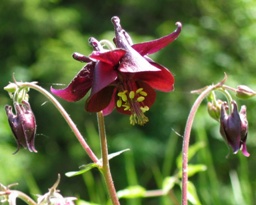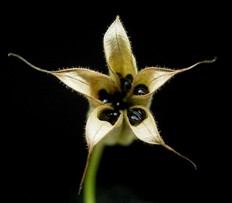Facts
 Columbine, having the intricate design of tripartite leaves
has caused various cultures across the world to associate this
flower with religious weight. In ancient Greek culture
Aquilegia was associated with the goddess Aphrodite, the
goddess of love. In Austria the flower was named " Five Birds
Together" because of the spurs on the top of the flower. The
doves relate to the holy spirit. This matches well with the
English nickname for Aquilegia Vulgaris, Columbine,
which means dove like.
Columbine, having the intricate design of tripartite leaves
has caused various cultures across the world to associate this
flower with religious weight. In ancient Greek culture
Aquilegia was associated with the goddess Aphrodite, the
goddess of love. In Austria the flower was named " Five Birds
Together" because of the spurs on the top of the flower. The
doves relate to the holy spirit. This matches well with the
English nickname for Aquilegia Vulgaris, Columbine,
which means dove like.
The tripartite leaves of Columbine were used as symbolism for
the holy trinity in Christianity. This can be seen in various
paintings and depictions in medieval art. Seven Columbine plants
together symbolized the seven gifts of the
©Harald Supfle, Wikicommons
holy spirit and three
flowers represented the three Christian virtues: hope, love, and
faith. Aquilegia is found in many paintings of Christ
and holds a symbolic meaning of bittersweet but it was not only
depicted in picture of Christ. The flower also appeared in
artwork of saints and prophets.
Medicinal uses
A quilegia
Vulgaris has been used for many remedies in the
past. Native Americans used small amounts of the concentrated
toxins in the roots and seeds to treat ulcers. Since the seeds
had a high concentration of toxins seeds would be rubbed into
the heads of Native Americans to control lice. The root has been
used to inhibit diarrhea and it has been used in lotions to
soothe the throat and aches of the body. There have been some
instances where the seeds when taken with wine help with
dilation in childbirth. Today however Aquilegia Vulgaris
is not used in products because there are more effective
treatments.
quilegia
Vulgaris has been used for many remedies in the
past. Native Americans used small amounts of the concentrated
toxins in the roots and seeds to treat ulcers. Since the seeds
had a high concentration of toxins seeds would be rubbed into
the heads of Native Americans to control lice. The root has been
used to inhibit diarrhea and it has been used in lotions to
soothe the throat and aches of the body. There have been some
instances where the seeds when taken with wine help with
dilation in childbirth. Today however Aquilegia Vulgaris
is not used in products because there are more effective
treatments.
There have been recent studies on the chemical isocytisoside (an
extract from the leaves and stem) that is finding the extract to
be a very powerful anti-oxidant. In a study the
©Frank Vincentz, Wikicommons
extract was given to male rats that had oxidation damage of the
liver and with treatment of the extract there was some recorded
recovery. The study is still fairly new so it has not progressed
to commercial use for anti oxidation yet. In other studies the
antimicrobial properties of the extract have been used to
inhibit the growth of bacteria and other organisms. This could
potentially lead to a range of products that stop bacteria from
growing in places that they are not needed.
Fun facts
There are approximately 65 different species of Aquilegia,
each one ha ving a different color arrangement and flower
pattern.
ving a different color arrangement and flower
pattern.
Some common nicknames for Aquilegia Vulgaris have been
Granny's nightcap, European Columbine, Granny's Bonnet, and
Common Columbine.
In the 19th century Aquilegia Vulgaris were used as
ornamentals for monastery gardens and manor houses. Later at
about the 19th century they began to be used in the common home.
If you would like to learn more take a look at the Resources
page here
_02.jpg)